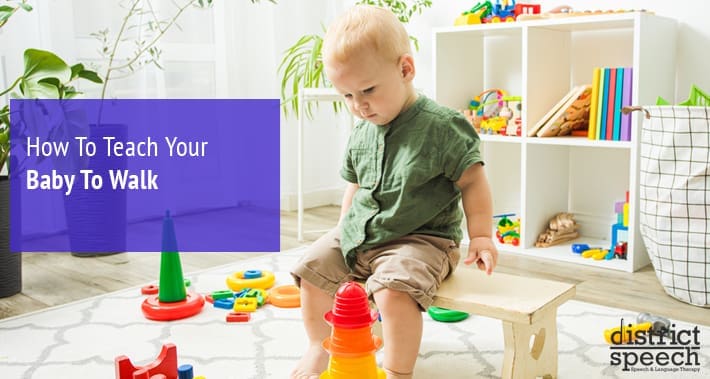
When your child begins to learn to walk, it can be both exciting and scary for parents.
Exciting because taking those first steps is an important developmental milestone which means your child is growing up, and literally taking those first steps towards independence.
And scary because this newfound independence means more chances for them to get into things they shouldn’t, or run off.
After all, once they start to walk, you no longer have total control of everywhere your child goes at all times.
It’s a good idea to baby proof your home at this point to help ensure their safety.
Despite that scariness however, parents do want to help their children reach this important milestone, and may wonder what normal development is when it comes to walking.
We’re District Speech, and as we offer DC pediatric physical therapy in addition to speech therapy for children.
RELATED : What’s The Best Age To Begin Speech Therapy?
If your child isn’t learning to walk at a rate comparable to their peers, we can help move things along.
Keep reading to learn more about this important milestone.
What Age Do Babies Learn To Walk?
In general, most children begin learning to walk at approximately one year of age.
Generally speaking, kids start to walk independently two to three months after learning to stand up.
It’s important to remember, however, these gross motor skills milestones are all on a continuum, and every child develops them at their own pace.
Some of the important pediatric physical therapy milestones your child will reach as they go from sitting to walking include:
- Standing with support
- Standing without support
- Walking while holding onto other objects (cruising)
- Taking unstable or wobbly steps
- Walking independently
How To Teach Your Baby To Walk
So, your child has just turned one, and you’re ready to help them learn to walk.
Let’s have a look at some things you can do to help them along.
1. Help Them Build Core Muscles
Your core muscles include those of the abdominals and back.
And these are important for providing support and stabilization while walking.
You can help your child build these core muscles by having them sit on a small bench while having them reach for toys on the ground, as well as having them reach overhead for items.
This can help them practice transitioning from positions such as standing up from a squatting or seated position.
2. Support Their Trunk
You have likely seen many photos of caregivers helping children walk by holding their arms up while they move around.
However, if you really want to set them up for walking success, rather than holding them by the hands while practicing walking, support their trunk instead.
This technique helps them learn to walk more naturally and distribute their weight more evenly.

3. Take Their Shoes Off
When first learning to walk, going barefoot can help a child get a better sense of their environment.
Feeling different surfaces, whether it be grass, carpet, or flooring allows their brain to adjust the way their muscles respond while walking.
Barefoot walking also helps increase stability, promotes weight shifting, and helps to strengthen the muscles of their feet.
4. Give Them Some Motivation
If your child needs an extra push to start walking, you may consider adding some extra motivation.
Try sitting away from them and holding a favorite toy, to give them something to reach for.
As their walking skills improve, set out a number of toys in a row and encourage moving from one to the next.
These techniques can also be used when helping children learn how to crawl, as well as help them to develop their motor skills.
5. Use Rolling Support Toys
Seeing children play with tiny child sized shopping carts, or doll sized strollers isn’t just adorable, it can help with learning to walk as well.
These sorts of push toys give children a chance to walk with some support, while also engaging in play.
Important considerations for these toys is where they’re meant to be used.
Some work well on carpet, others are better on floors and some are meant to be used outside.
It’s also important to consider the weight of the toy itself – a heavier toy will make walking a bit slower, which may be ideal if you’re worried about safety.
How NOT To Teach Your Baby To Walk
Although push toys can be useful in helping children learn to walk, baby walkers should be avoided.
These are apparatus which allow babies to sit inside them, and move around on wheels while your baby pushes off on their feet.
Walkers are considered extremely dangerous, as children have been injured in them rolling down stairs, or into areas they shouldn’t be in.
In addition, it’s important to work with your baby and not push them too much – their brains and bodies are still developing, and coordination may still be developing.
How To Tell If Your Baby Needs Help
We mentioned at the beginning that most children will start walking by one year of age.
If it’s been a few weeks since their first birthday, it’s not time to panic yet.
However, after a couple of months if they’re still not showing signs of starting to walk, further intervention may be needed.
This means it might be time to seek the help of a pediatric physical therapist.
If your baby has been diagnosed with any of the following conditions, they may need help from a pediatric physical therapist:
- Down syndrome
- Premature birth
- Developmental hip dysplasia
- Cerebral palsy
- Muscular dystrophy
- Rickets
- Frequent childhood infections
- Traumatic brain injury
RELATED : Speech Issues Common In Premature Babies
Plus, depending on the nature of the condition, as your child grows they may also need pediatric speech therapy which can have great benefits beyond just improving their speaking ability.
Speech therapy can help improve your child’s mental health and even strengthen your child’s memory.
Book Your Appointment With District Speech Today
If you’re worried your child isn’t learning to walk at the rate you think they should be, we can help.
We’re District Speech, servicing Washington DC and Arlington VA, as well as the surrounding areas.
We have qualified physical therapists on staff who can offer assessment services to determine what’s causing your child’s challenges, and treat them.
Book your appointment with District Speech today.
1300 I St NW, Suite 400 E,
Washington, DC 20005
- https://g.page/districtspeech
District Speech and Language Therapy specializes in speech therapy, physical therapy, and occupational therapy solutions, for both children and adults, in the Washington D.C and the Arlington Virginia areas.